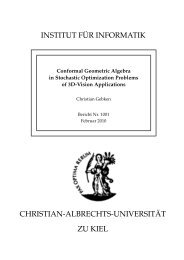Curry: An Integrated Functional Logic Language
Curry: An Integrated Functional Logic Language
Curry: An Integrated Functional Logic Language
Create successful ePaper yourself
Turn your PDF publications into a flip-book with our unique Google optimized e-Paper software.
1 Introduction<br />
<strong>Curry</strong> is a universal programming language aiming at the amalgamation of the most important<br />
declarative programming paradigms, namely functional programming and logic programming.<br />
<strong>Curry</strong> combines in a seamless way features from functional programming (nested expressions, lazy<br />
evaluation, higher-order functions), logic programming (logical variables, partial data structures,<br />
built-in search), and concurrent programming (concurrent evaluation of constraints with synchronization<br />
on logical variables). Moreover, <strong>Curry</strong> provides additional features in comparison to the<br />
pure languages (compared to functional programming: search, computing with partial information;<br />
compared to logic programming: more efficient evaluation due to the deterministic evaluation of<br />
functions). Moreover, it also amalgamates the most important operational principles developed<br />
in the area of integrated functional logic languages: “residuation” and “narrowing” (see [21] for a<br />
survey on functional logic programming).<br />
The development of <strong>Curry</strong> is an international initiative intended to provide a common platform<br />
for the research, teaching 1 and application of integrated functional logic languages. This document<br />
describes the features of <strong>Curry</strong>, its syntax and operational semantics.<br />
2 Programs<br />
A <strong>Curry</strong> program specifies the semantics of expressions, where goals, which occur in logic programming,<br />
are particular expressions (of type Success, cf. Section 4.1.2, page 15). Executing a<br />
<strong>Curry</strong> program means simplifying an expression until a value (or solution) is computed. To distinguish<br />
between values and reducible expressions, <strong>Curry</strong> has a strict distinction between (data)<br />
constructors and operations or defined functions on these data. Hence, a <strong>Curry</strong> program consists<br />
of a set of type and function declarations. The type declarations define the computational domains<br />
(constructors) and the function declarations the operations on these domains. Predicates in the<br />
logic programming sense can be considered as constraints, i.e., functions with result type Success.<br />
Modern functional languages (e.g., Haskell [27], SML [36]) allow the detection of many programming<br />
errors at compile time by the use of polymorphic type systems. Similar type systems<br />
are also used in modern logic languages (e.g., Gödel [26], λProlog [38]). <strong>Curry</strong> follows the same<br />
approach, i.e., it is a strongly typed language with a Hindley/Milner-like polymorphic type system<br />
[13]. 2 Each object in a program has a unique type, where the types of variables and operations can<br />
be omitted and are reconstructed by a type inference mechanism.<br />
2.1 Datatype Declarations<br />
A datatype declaration has the form<br />
data T α1 ... αn = C1 τ11 ... τ1n1 | · · · | Ck τk1 ... τknk<br />
1 Actually, <strong>Curry</strong> has been successfully applied to teach functional and logic programming techniques in a single<br />
course without switching between different programming languages. More details about this aspect can be found in<br />
[22].<br />
2The extension of this type system to Haskell’s type classes is not included in the kernel language but could be<br />
considered in a future version.<br />
3
















